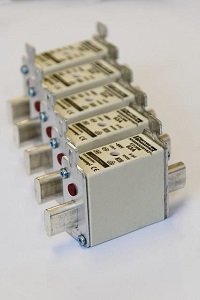
What is a Fuse in Electricity and Types of Fuses with Symbols
In this article, we will be discussing the fuse in the electrical circuit. A fuse is generally a small piece of metal wire that is connected between the two terminals and is mounted on the insulating plate or base.
A fuse is inserted in series with the circuit to be protected. The fuse element is made of a material which is having a low melting point and high conductivity and less deterioration due to oxidation. Some of the metals with this kind of properties are copper, aluminum, tin, silver, etc.
Whenever the excessive current flows through the circuit then the fuse gets melted and prevents damage to the electrical system components. Thus, we can define a fuse as a protection device that is used to protect the electrical equipment against short circuits and overloads.
How does a fuse protect the system?
whenever equipment is running then the fuse carries the normal current as per the rating of the fuse without getting overheated. However, when a short circuit or overload occurs then the current through the fuse increased beyond its rated value and this, in turn, raises the temperature, and the fuse element melts down thereby disconnecting the circuit. That is how a fuse protects the electrical system or equipment due to excessive currents.
Characteristics of Fuse Element
As we have already discussed the function of a fuse is to carry the normal current under normal circumstances but whenever the current exceeds the rated value it gets melted and disconnects the electrical system. For the satisfactory working of the fuse element it should have the following desirable characteristics:
- High conductivity
- Low melting point
- Low cost
- Free from deterioration due to oxidation.
Important Terms Related to Fuse
The following terms need to understand for the study and analysis of the fuse:
1. The current rating of a fuse element
The current rating is the maximum current that a fuse element can carry safely without getting overheated and melting.
2. Fusing Current
the fusing current is the minimum current at which the fuse element get melted. The value of the fusing current will be more than the current rating of the fuse element.
3. Fusing Factor
The fusing factor is defined as the ratio of minimum fusing current to the fuse’s current rating.
Fusing Factor = Minimum Fusing Current / Current Rating of Fuse
4. Cut off Current
Cut-off current is the maximum value of the current actually reached before the fuse melts.
5. Pre-Arcing Time
Pre-Arcing Time is the time between the commencement of fault and the instant when cut off occurs. It is denoted by TPA.
6. Arcing Time
Arcing Time is the time between the end of pre-arcing time and the instant when the arc is extinguished. It is denoted by ta.
7. Total Operating Time
total operating time is the sum of Pre arcing and arcing times.
8. Breaking Capacity
Breaking capacity is the rms value of the AC component of the maximum protective current that a fuse can deal with.
Types of Fuse
In general, a fuse can be divided into two categories:
- Low Voltage Fuse
- High Voltage Fuse
We will discuss each of them one by one.
1. Low Voltage Fuse
These can be divided into the following types depending upon the fuse rating:
- Semi-enclosed Fuse (Rewirable)
- Cartridge Fuse
- High Breaking Capacity (H.B.C) Fuses or High Rupturing Capacity (H.R.C)
We will discuss each of them in the following paragraphs:
a.) Semi-enclosed Fuse (Rewirable)
A Semi-enclosed fuse is also known as a kit-kat type consisting of a base and a fuse carrier. The base and fuse carrier are made of porcelain. The base carries the fixed contacts for connecting the input and output terminals. The Fuse carrier holds the fuse elements between terminals. The fuse carrier can be inserted or detached whenever desired.
Whenever there are excessive current flows through the circuit, the fuse element gets heated and break the circuit. Then fuse carrier is taken out and the blown away fuse is changed with the new fuse and put back in the circuit. This type of use is used where low value of fault currents is interrupted.
b.) Cartridge Fuse
In the cartridge-type fuse, the wire is enclosed in a cartridge-type container. These are of cylindrical shape. It should be noted that, whenever a cartridge-type fuse is blown out, then it should be replaced with the same size and rating as the cartridge fuse otherwise serious hazards may occur.
The cartridge may vary in length so that it should match the fuse rating of the circuit that needs to be protected so that the wrong size of a fuse cannot be inserted.
c.) High Breaking Capacity (H.B.C) Fuses

High breaking capacity fuses are used where large currents and energy level is high. High-breaking capacity fuses are cartridge-type fuses in which there is a silver fuse element that is connected between the two ends of a ceramic tube filled with the special quartz powder.
Whenever the fuse is blown, there is a fusion of the silver vapors produced with the feeling powder, and quenching of Arc occurs. This type of fuse does not deteriorate and has a high speed of operation.
2. High Voltage Fuse
High voltage fuses are used for voltage up to 33KV and are of three main types:
- Cartridge type fuse
- Liquid type fuse
- Metal cald type fuse
Let us discuss each of them one by one:
a.) Cartridge Type Fuse
Cartridge type fuse is similar to that we have discussed in the low voltage fuse but it has some special design features. In this case, there are two fuse elements that are in parallel one is having low resistance and the second is having high resistance. During the normal condition, the low resistance carries the current but in the case of a fault condition, the low resistance fuse is blown away and the high resistance element reduces the short circuit current and thereby breaking the circuit.
b.) Liquid Type Fuse
This type of fuse are filled with carbon tetrachloride and has the widest range of applications. These can be used for circuits up to 400A rated current on a system of 132KV.
c.) Metal Clad Type Fuse
These are used as a substitute for the oil circuit breakers. These fuses can be used for very high voltage circumstances and operate satisfactorily.
Also, Check Electricity Bill Calculator
What is a Fuse?
A fuse is generally a small piece of metal wire that is connected between the two terminals and is mounted on the insulating plate or base.
How many Different types of Fuse are there?
In general, a fuse can be divided into two categories:
1. Low Voltage Fuse
2. High Voltage Fuse
